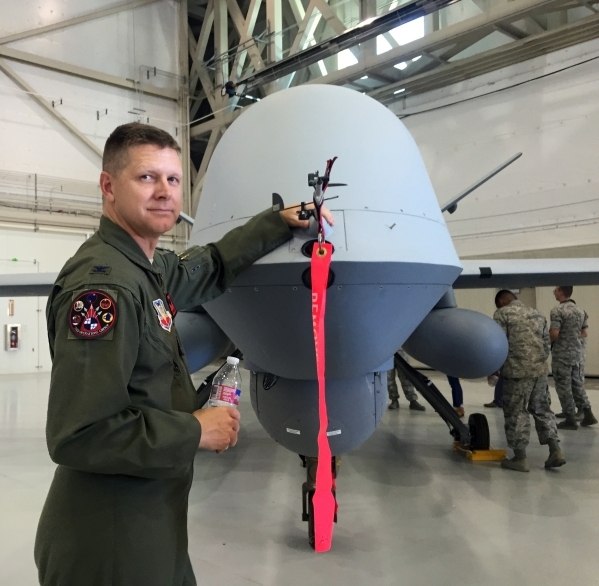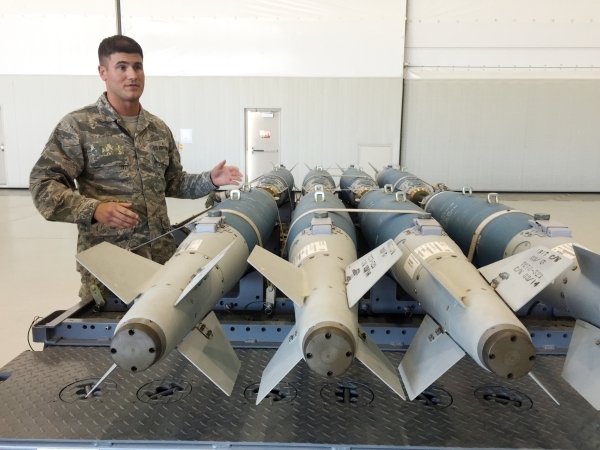Creech, other drone bases get help to handle growth
The Air Force is launching a full-court press to meet increased demand from combat commanders for more drone missions such as those controlled from Creech Air Force Base to fight the nation's global war on terrorism.
While the focus remains on continuing the fight with armed Reaper and Predator aircraft, the effort adds incentives to retain pilots, and a new dimension to train enlisted personnel to fly unmanned Global Hawk spy planes for getting the big picture over trouble spots like the Middle East and Southwest Asia.
The so-called "kinetic" missions in which laser-guided missiles are fired from MQ-1B Predators, and smart bombs as well Hellfire missiles are shot from MQ-9 Reapers will continue to be controlled from Creech and other bases by crews of officer-rated pilots and enlisted sensor operators.
Some nonkinetic missions for intelligence, surveillance and reconnaissance will be farmed out to contractors to reduce the strain on regular Air Force crews who have absorbed constant increases in demand.
"Basically this means Creech Air Force Base has been doing (its) job too well," Air Combat Command spokesman Ben Newell said.
He said the goal is to maintain the current level of combat air patrols at 60 and eventually increase the number to 70 with 10 flown by contractors as nonkinetic missions. Each combat air patrol involves four drones in a 24-hour span to hunt high-value terrorists, such as leaders and planners in addition to other militant targets and strongholds.
Newell said the command structure at Creech, 45 miles northwest of Las Vegas in Indian Springs, will be reorganized, but there will be no immediate changes to the base itself.
"But airmen who work there will see changes in day-to-day lives and access to professional development opportunities. They're going to go to graduate-level schools and command colleges," he said last week, adding that they've been permanently deployed in the United States so long that they've been unable to pursue career development paths.
Money talks
The Air Force strategy to meet the drone demand unfolded in a series of recent announcements. It will take about six months to implement some of the recommendations from Air Force leaders.
On Dec. 15, Chief of Staff Gen. Mark A. Welsh said the Air Force will offer handsome pay bonuses to retain remotely piloted aircraft pilots.
His announcement came on the heels of Air Combat Command's Dec. 10 release of a study that calls for almost doubling the number remotely piloted aircraft flying squadrons. Gen. Herbert "Hawk" Carlisle, commander of Air Combat Command, directed his staff to develop a plan for new squadrons and, among other things, increasing remotely piloted aircraft personnel by up to 3,000 airmen.
Then on Dec. 17, Secretary of the Air Force Deborah Lee James announced that enlisted airmen for the first time will serve as pilots to fly the fleet of high-altitude RQ-4 Global Hawk remote-controlled aircraft on intelligence, surveillance and reconnaissance missions.
"Our enlisted force is the best in the world and I am completely confident they will be able to do the job and do it well," James said in announcing she has directed Air Combat Command to develop a plan over the next six months to put enlisted personnel in the pilot seats at Global Hawk ground-control stations.
Welsh added that the Global Hawk enlisted experiment could open doors for enlisted crews to pilot other aircraft.
"What we learn from flying Global Hawks with enlisted pilots under the supervision of rated officers will inform whether we apply a similar approach to other weapon systems," he said.
To retain the experienced RPA officer cadre, Welsh said eligible active-duty pilots will have until Sept. 30 to apply for "aviator retention pay" or "critical skills retention" bonuses. That translates to between $75,000 and $225,000 for retention pay depending on years of service commitment, or up to $125,000 for a retention bonus.
RPA pilots who have racked up six years of aviation service after completing undergraduate RPA training can receive a bonus of five yearly installments of $25,000 with an option to receive half of the total bonus payable upfront.
"These airmen are making extremely important contributions to the fight," James said when the incentive plan was rolled out Dec. 15. "We need these professionals to stay with us and we're committed to retaining them in our force."
Creech leads charge
While most of the Air Force's 33 Global Hawks are operated from Beale Air Force Base near Marysville, Calif., the nation's hub for controlling Predator and Reaper overseas operations via satellite links remains at Creech.
That's where the technology sprouted in the late 1990s. The demand has grown exponentially ever since Feb. 21, 2001, when Capt. Curt Hawes and Master Sgt. Leo Glovka made history by becoming the first crew to remotely fly a Predator and fire a laser-guided Hellfire missile to knock out a tank from 2,000 feet high and 3 miles away on the test range near Indian Springs.
That set the tone for many drone attacks and spy missions to come, including a Predator operation controlled from Nellis Air Force Base that helped U.S. soldiers capture Iraqi dictator Saddam Hussein on Dec. 13, 2003.
By 2005, Indian Springs Auxiliary Airfield had been renamed Creech Air Force Base, where pilots and sensor operators sat at computer consoles in ground stations to control RPAs over battlefields thousands of miles away. Another drone, the jet-powered RQ-170 Sentinel, or "Beast of Kandahar," was home-based at the Tonopah Test Range, 30 miles southeast of Tonopah in Nye County.
This month's announced changes to the remotely piloted aircraft program evolved from a survey of crews and support staff in the program.
Newell said the decision to almost double the number of squadrons targets four bases that have communication systems in place for handling remote operations — Langley in Virginia; Beale in California; Davis-Monthan in Arizona; and Royal Air Force Mildenhall in the United Kingdom.
"Those all have existing communication structures," he said. "You don't need to build a runway. You need to communicate: send electrons from one end of the world to the other."
— Contact Keith Rogers at krogers@reviewjournal.com or 702-383-0308. Follow him: @KeithRogers2



















